Abstract
We investigated the role of bacterial mannose-resistant fimbriation of S fimbriae (Fim), mannose-resistant hemagglutination (S-Mrh), and hemolysin (Hly) production by an Escherichia coli parent and genetically cloned strains as regards their effect on histamine release from rat mast cells and generation of the chemiluminescence response, leukotriene, and enzyme release from human polymorphonuclear granulocytes. These mediators are involved in the induction of inflammatory disease processes and lead, e.g., to the enhancement of vascular permeability, chemotaxis, aggregation of granulocytes (leukotriene B4), lysosomal enzyme release, and smooth-muscle contraction (leukotrienes C4, D4, and E4). The content of azurophilic and specific granules in polymorphonuclear granulocytes consists of highly reactive enzymes which amplify inflammatory reactions. Washed bacteria (E. coli 764 Hly+/-, E. coli 21085 Hly+/- Fim+/- Mrh+/-), as well as their culture supernatants, were analyzed at various times during their growth cycle. No differences exist between parent and cloned or mutant strains with respect to their outer membrane proteins and lipopolysaccharide pattern. Washed bacteria [E. coli 764 and 21085(pANN202-312)] which produced hemolysin, unlike Hly- strains, induced high levels of histamine release from rat mast cells and led to a significant chemiluminescence response and enzyme and leukotriene release from human polymorphonuclear granulocytes. Bacterial culture supernatants from Hly+ and secreting strains showed similar results with the exception of E. coli 21085(pANN202-312), which is a hemolysin-producing but not a secretory strain. Our data suggest a potent role for hemolysin as a stimulus for noncytotoxic mediator release from various cells. Furthermore, we showed that the presence of Fim and S Mrh potentiates mediator release. The simultaneous presence of Mrh and Fim [E. coli 535/21(pANN801-4)] increased mediator release compared with Mrh+ Fim- strains [E. coli 536/21(pANN801-1)]. E. coli 536/21 (Msh- Mrh- Fim- Hly-) did not induce mediator release.
Full text
PDF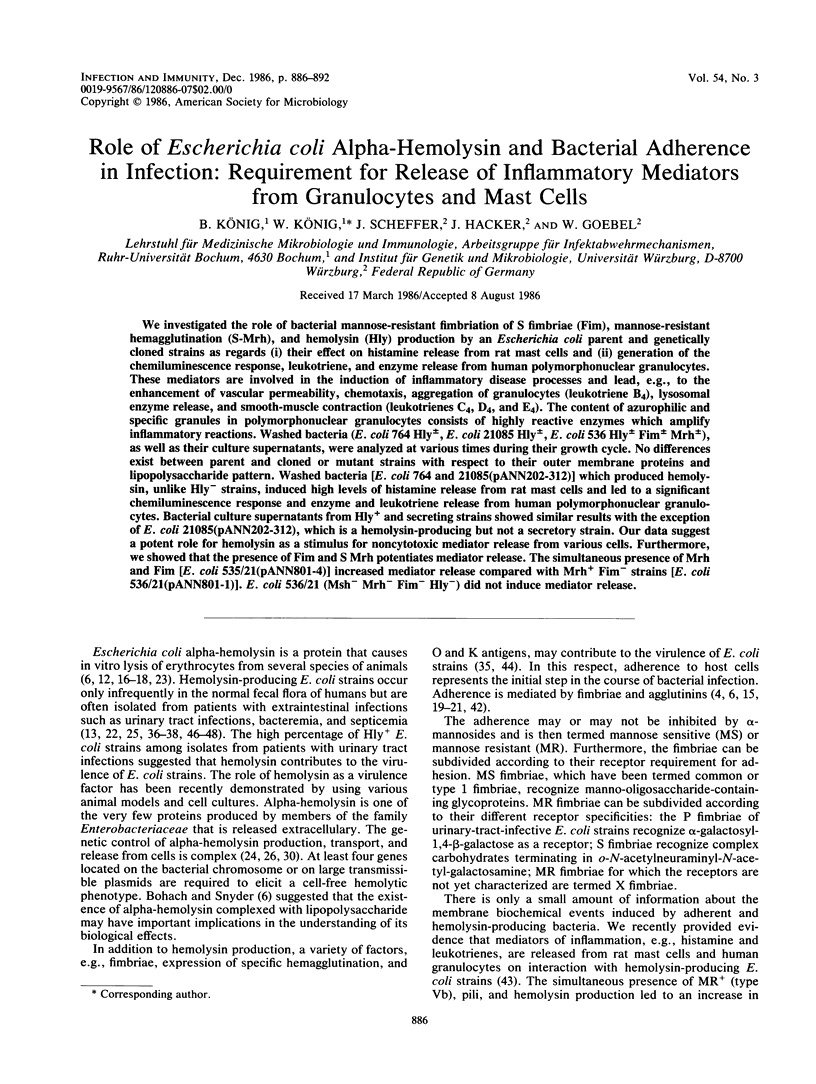

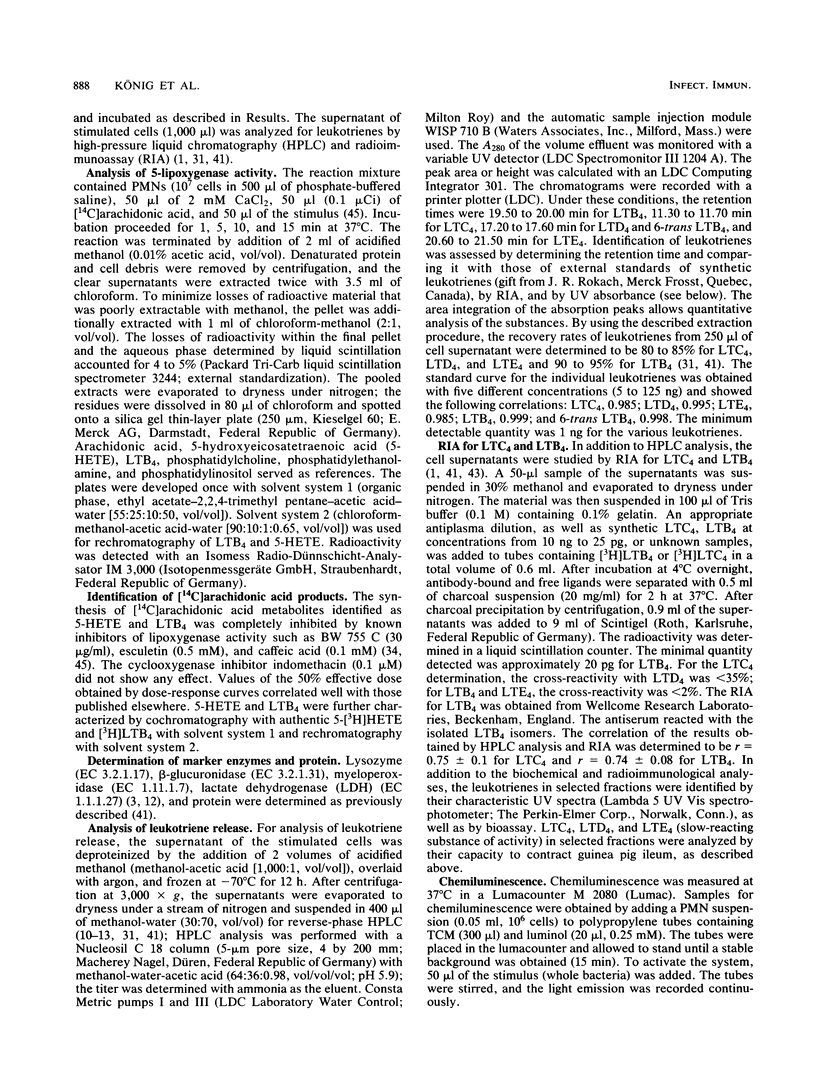
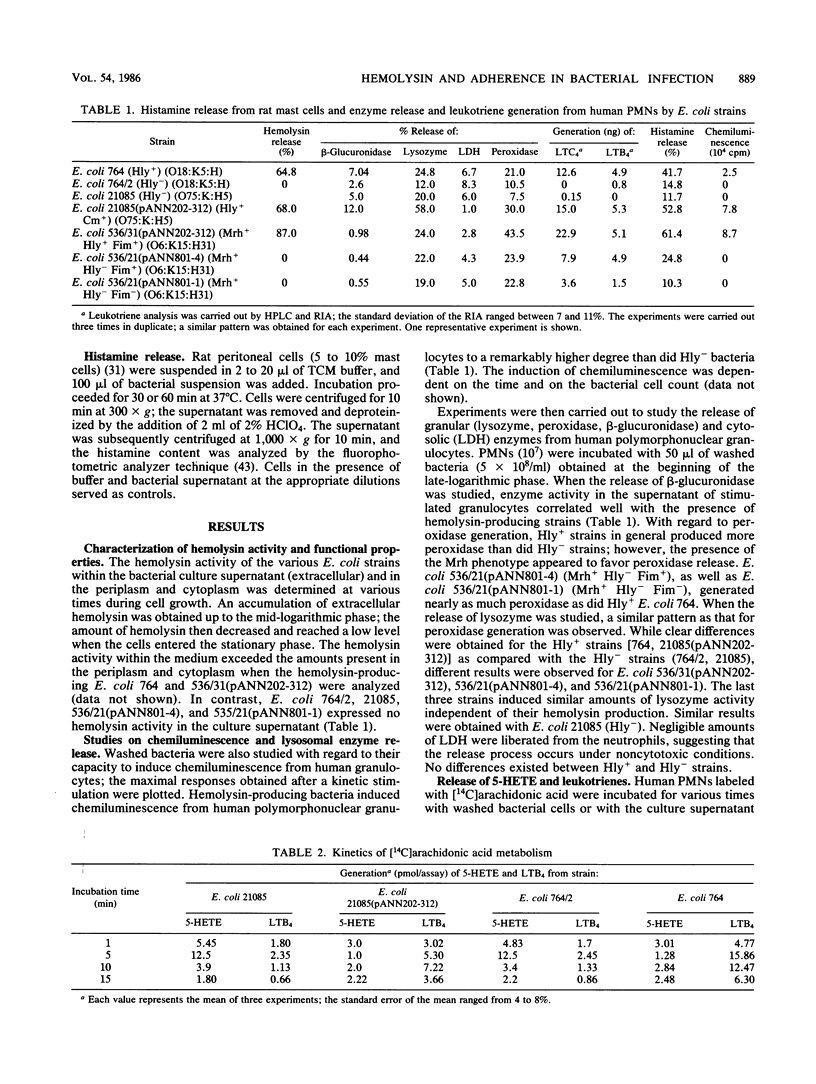

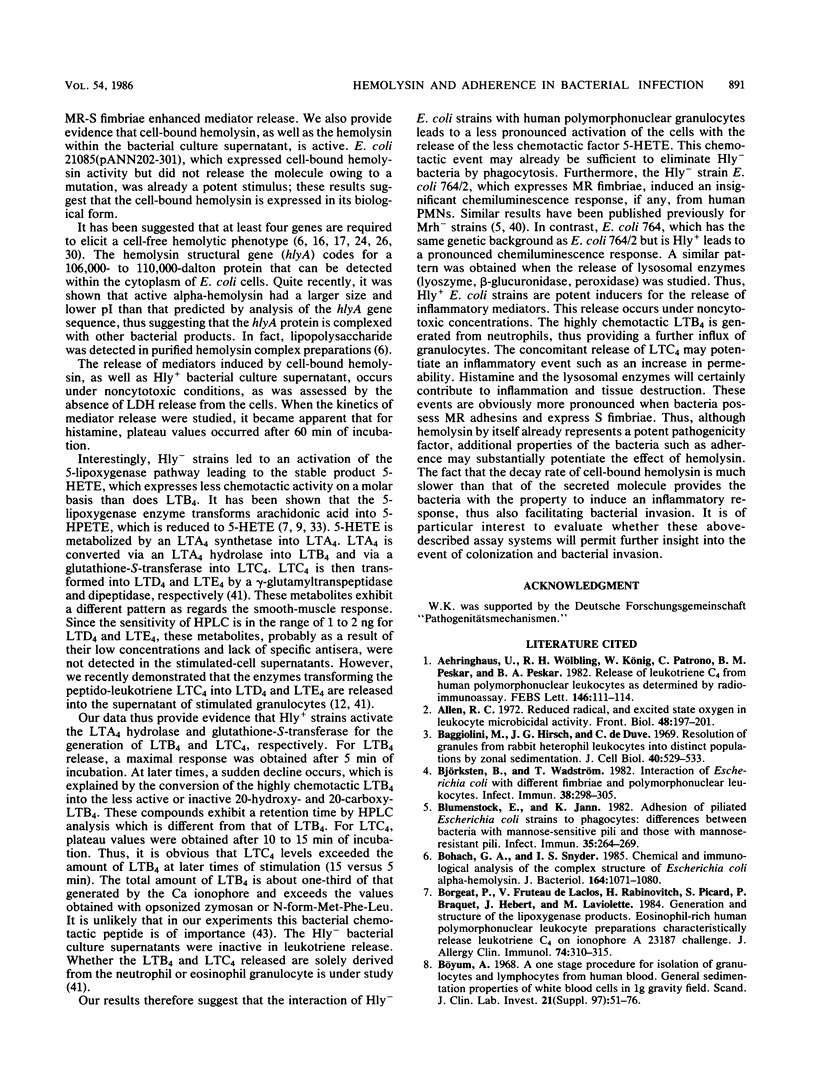
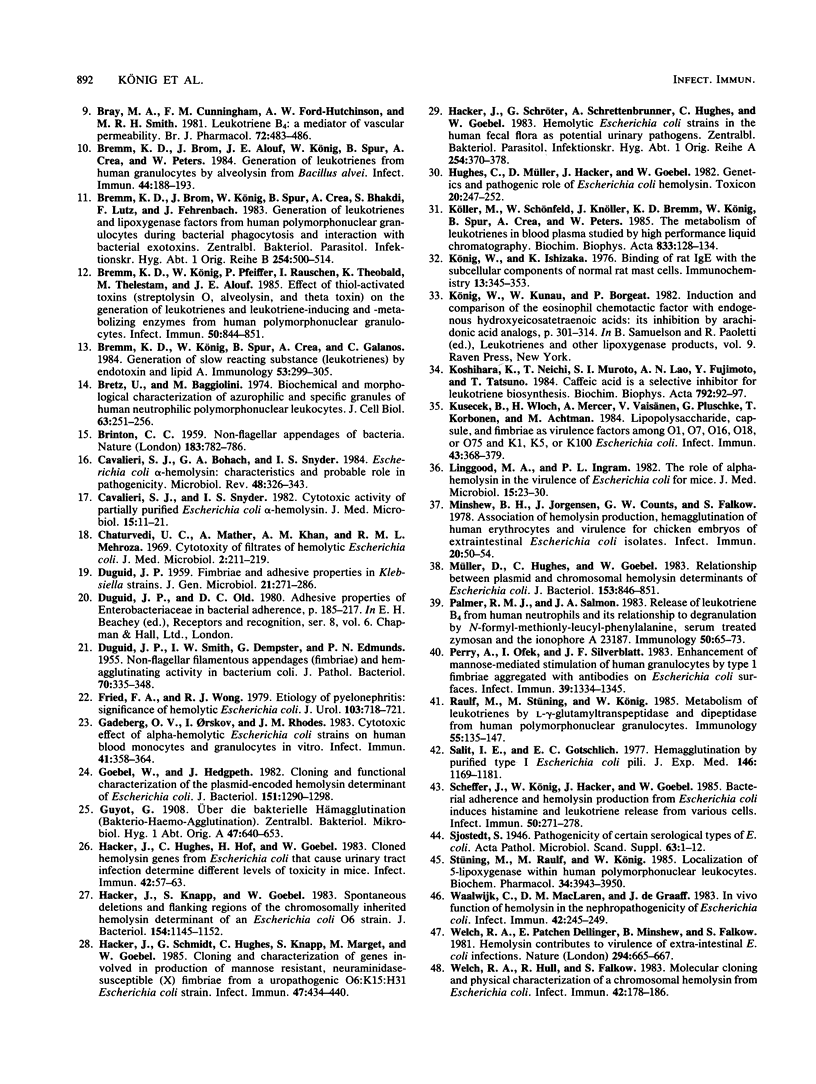
Selected References
These references are in PubMed. This may not be the complete list of references from this article.
- Aehringhaus U., Wölbling R. H., König W., Patrono C., Peskar B. M., Peskar B. A. Release of leukotriene C4 from human polymorphonuclear leucocytes as determined by radioimmunoassay. FEBS Lett. 1982 Sep 6;146(1):111–114. doi: 10.1016/0014-5793(82)80715-1. [DOI] [PubMed] [Google Scholar]
- Allen R. C. Reduced, radical, and excited state oxygen in leukocyte microbicidal activity. Front Biol. 1979;48:197–233. [PubMed] [Google Scholar]
- BRINTON C. C., Jr Non-flagellar appendages of bacteria. Nature. 1959 Mar 21;183(4664):782–786. doi: 10.1038/183782a0. [DOI] [PubMed] [Google Scholar]
- Baggiolini M., Hirsch J. G., De Duve C. Resolution of granules from rabbit heterophil leukocytes into distinct populations by zonal sedimentation. J Cell Biol. 1969 Feb;40(2):529–541. doi: 10.1083/jcb.40.2.529. [DOI] [PMC free article] [PubMed] [Google Scholar]
- Björkstén B., Wadström T. Interaction of Escherichia coli with different fimbriae and polymorphonuclear leukocytes. Infect Immun. 1982 Oct;38(1):298–305. doi: 10.1128/iai.38.1.298-305.1982. [DOI] [PMC free article] [PubMed] [Google Scholar]
- Blumenstock E., Jann K. Adhesion of piliated Escherichia coli strains to phagocytes: differences between bacteria with mannose-sensitive pili and those with mannose-resistant pili. Infect Immun. 1982 Jan;35(1):264–269. doi: 10.1128/iai.35.1.264-269.1982. [DOI] [PMC free article] [PubMed] [Google Scholar]
- Bohach G. A., Snyder I. S. Chemical and immunological analysis of the complex structure of Escherichia coli alpha-hemolysin. J Bacteriol. 1985 Dec;164(3):1071–1080. doi: 10.1128/jb.164.3.1071-1080.1985. [DOI] [PMC free article] [PubMed] [Google Scholar]
- Borgeat P., Fruteau de Laclos B., Rabinovitch H., Picard S., Braquet P., Hébert J., Laviolette M. Eosinophil-rich human polymorphonuclear leukocyte preparations characteristically release leukotriene C4 on ionophore A23187 challenge. J Allergy Clin Immunol. 1984 Sep;74(3 Pt 2):310–315. doi: 10.1016/0091-6749(84)90122-2. [DOI] [PubMed] [Google Scholar]
- Bray M. A., Cunningham F. M., Ford-Hutchinson A. W., Smith M. J. Leukotriene B4: a mediator of vascular permeability. Br J Pharmacol. 1981 Mar;72(3):483–486. doi: 10.1111/j.1476-5381.1981.tb11000.x. [DOI] [PMC free article] [PubMed] [Google Scholar]
- Bremm K. D., Brom H. J., Alouf J. E., König W., Spur B., Crea A., Peters W. Generation of leukotrienes from human granulocytes by alveolysin from Bacillus alvei. Infect Immun. 1984 Apr;44(1):188–193. doi: 10.1128/iai.44.1.188-193.1984. [DOI] [PMC free article] [PubMed] [Google Scholar]
- Bremm K. D., Brom J., König W., Spur B., Crea A., Bhakdi S., Lutz F., Fehrenbach F. J. Generation of leukotrienes and lipoxygenase factors from human polymorphonuclear granulocytes during bacterial phagocytosis and interaction with bacterial exotoxins. Zentralbl Bakteriol Mikrobiol Hyg A. 1983 Jul;254(4):500–514. [PubMed] [Google Scholar]
- Bremm K. D., König W., Pfeiffer P., Rauschen I., Theobald K., Thelestam M., Alouf J. E. Effect of thiol-activated toxins (streptolysin O, alveolysin, and theta toxin) on the generation of leukotrienes and leukotriene-inducing and -metabolizing enzymes from human polymorphonuclear granulocytes. Infect Immun. 1985 Dec;50(3):844–851. doi: 10.1128/iai.50.3.844-851.1985. [DOI] [PMC free article] [PubMed] [Google Scholar]
- Bremm K. D., König W., Spur B., Crea A., Galanos C. Generation of slow-reacting substance (leukotrienes) by endotoxin and lipid A from human polymorphonuclear granulocytes. Immunology. 1984 Oct;53(2):299–305. [PMC free article] [PubMed] [Google Scholar]
- Bretz U., Baggiolini M. Biochemical and morphological characterization of azurophil and specific granules of human neutrophilic polymorphonuclear leukocytes. J Cell Biol. 1974 Oct;63(1):251–269. doi: 10.1083/jcb.63.1.251. [DOI] [PMC free article] [PubMed] [Google Scholar]
- Böyum A. A one-stage procedure for isolation of granulocytes and lymphocytes from human blood. General sedimentation properties of white blood cells in a 1g gravity field. Scand J Clin Lab Invest Suppl. 1968;97:51–76. [PubMed] [Google Scholar]
- Cavalieri S. J., Bohach G. A., Snyder I. S. Escherichia coli alpha-hemolysin: characteristics and probable role in pathogenicity. Microbiol Rev. 1984 Dec;48(4):326–343. doi: 10.1128/mr.48.4.326-343.1984. [DOI] [PMC free article] [PubMed] [Google Scholar]
- Cavalieri S. J., Snyder I. S. Cytotoxic activity of partially purified Escherichia coli alpha haemolysin. J Med Microbiol. 1982 Feb;15(1):11–21. doi: 10.1099/00222615-15-1-11. [DOI] [PubMed] [Google Scholar]
- Chaturvedi U. C., Mathur A., Khan A. M., Mehrotra R. M. Cytotoxicity of filtrates of haemolytic Escherichia coli. J Med Microbiol. 1969 Aug;2(3):211–218. doi: 10.1099/00222615-2-3-211. [DOI] [PubMed] [Google Scholar]
- DUGUID J. P. Fimbriae and adhesive properties in Klebsiella strains. J Gen Microbiol. 1959 Aug;21:271–286. doi: 10.1099/00221287-21-1-271. [DOI] [PubMed] [Google Scholar]
- DUGUID J. P., SMITH I. W., DEMPSTER G., EDMUNDS P. N. Non-flagellar filamentous appendages (fimbriae) and haemagglutinating activity in Bacterium coli. J Pathol Bacteriol. 1955 Oct;70(2):335–348. doi: 10.1002/path.1700700210. [DOI] [PubMed] [Google Scholar]
- Fried F. A., Wong R. J. Etiology of pyelonephritis: significance of hemolytic Escherichia coli. J Urol. 1970 Jun;103(6):718–721. doi: 10.1016/s0022-5347(17)62033-0. [DOI] [PubMed] [Google Scholar]
- Gadeberg O. V., Orskov I., Rhodes J. M. Cytotoxic effect of an alpha-hemolytic Escherichia coli strain on human blood monocytes and granulocytes in vitro. Infect Immun. 1983 Jul;41(1):358–364. doi: 10.1128/iai.41.1.358-364.1983. [DOI] [PMC free article] [PubMed] [Google Scholar]
- Goebel W., Hedgpeth J. Cloning and functional characterization of the plasmid-encoded hemolysin determinant of Escherichia coli. J Bacteriol. 1982 Sep;151(3):1290–1298. doi: 10.1128/jb.151.3.1290-1298.1982. [DOI] [PMC free article] [PubMed] [Google Scholar]
- Hacker J., Hughes C., Hof H., Goebel W. Cloned hemolysin genes from Escherichia coli that cause urinary tract infection determine different levels of toxicity in mice. Infect Immun. 1983 Oct;42(1):57–63. doi: 10.1128/iai.42.1.57-63.1983. [DOI] [PMC free article] [PubMed] [Google Scholar]
- Hacker J., Knapp S., Goebel W. Spontaneous deletions and flanking regions of the chromosomally inherited hemolysin determinant of an Escherichia coli O6 strain. J Bacteriol. 1983 Jun;154(3):1145–1152. doi: 10.1128/jb.154.3.1145-1152.1983. [DOI] [PMC free article] [PubMed] [Google Scholar]
- Hacker J., Schmidt G., Hughes C., Knapp S., Marget M., Goebel W. Cloning and characterization of genes involved in production of mannose-resistant, neuraminidase-susceptible (X) fimbriae from a uropathogenic O6:K15:H31 Escherichia coli strain. Infect Immun. 1985 Feb;47(2):434–440. doi: 10.1128/iai.47.2.434-440.1985. [DOI] [PMC free article] [PubMed] [Google Scholar]
- Hacker J., Schröter G., Schrettenbrunner A., Hughes C., Goebel W. Hemolytic Escherichia coli strains in the human fecal flora as potential urinary pathogens. Zentralbl Bakteriol Mikrobiol Hyg A. 1983 May;254(3):370–378. [PubMed] [Google Scholar]
- Hughes C., Müller D., Hacker J., Goebel W. Genetics and pathogenic role of Escherichia coli haemolysin. Toxicon. 1982;20(1):247–252. doi: 10.1016/0041-0101(82)90210-0. [DOI] [PubMed] [Google Scholar]
- Koshihara Y., Neichi T., Murota S., Lao A., Fujimoto Y., Tatsuno T. Caffeic acid is a selective inhibitor for leukotriene biosynthesis. Biochim Biophys Acta. 1984 Jan 17;792(1):92–97. [PubMed] [Google Scholar]
- Kusecek B., Wloch H., Mercer A., Vaisänen V., Pluschke G., Korhonen T., Achtman M. Lipopolysaccharide, capsule, and fimbriae as virulence factors among O1, O7, O16, O18, or O75 and K1, K5, or K100 Escherichia coli. Infect Immun. 1984 Jan;43(1):368–379. doi: 10.1128/iai.43.1.368-379.1984. [DOI] [PMC free article] [PubMed] [Google Scholar]
- Köller M., Schönfeld W., Knöller J., Bremm K. D., König W., Spur B., Crea A., Peters W. The metabolism of leukotrienes in blood plasma studied by high-performance liquid chromatography. Biochim Biophys Acta. 1985 Jan 9;833(1):128–134. doi: 10.1016/0005-2760(85)90260-7. [DOI] [PubMed] [Google Scholar]
- König W., Ishizaka K. Binding of rat IgE with the subcellular components of normal rat mast cells. Immunochemistry. 1976 Apr;13(4):345–353. doi: 10.1016/0019-2791(76)90346-3. [DOI] [PubMed] [Google Scholar]
- König W., Kunau H. W., Borgeat P. Induction and comparison of the eosinophil chemotactic factor with endogenous hydroxyeicosatetraenoic acids: its inhibition by arachidonic acid analogs. Adv Prostaglandin Thromboxane Leukot Res. 1982;9:301–314. [PubMed] [Google Scholar]
- Linggood M. A., Ingram P. L. The role of alpha haemolysin in the virulence of Escherichia coli for mice. J Med Microbiol. 1982 Feb;15(1):23–30. doi: 10.1099/00222615-15-1-23. [DOI] [PubMed] [Google Scholar]
- Minshew B. H., Jorgensen J., Counts G. W., Falkow S. Association of hemolysin production, hemagglutination of human erythrocytes, and virulence for chicken embryos of extraintestinal Escherichia coli isolates. Infect Immun. 1978 Apr;20(1):50–54. doi: 10.1128/iai.20.1.50-54.1978. [DOI] [PMC free article] [PubMed] [Google Scholar]
- Müller D., Hughes C., Goebel W. Relationship between plasmid and chromosomal hemolysin determinants of Escherichia coli. J Bacteriol. 1983 Feb;153(2):846–851. doi: 10.1128/jb.153.2.846-851.1983. [DOI] [PMC free article] [PubMed] [Google Scholar]
- Palmer R. M., Salmon J. A. Release of leukotriene B4 from human neutrophils and its relationship to degranulation induced by N-formyl-methionyl-leucyl-phenylalanine, serum-treated zymosan and the ionophore A23187. Immunology. 1983 Sep;50(1):65–73. [PMC free article] [PubMed] [Google Scholar]
- Perry A., Ofek I., Silverblatt F. J. Enhancement of mannose-mediated stimulation of human granulocytes by type 1 fimbriae aggregated with antibodies on Escherichia coli surfaces. Infect Immun. 1983 Mar;39(3):1334–1345. doi: 10.1128/iai.39.3.1334-1345.1983. [DOI] [PMC free article] [PubMed] [Google Scholar]
- Raulf M., Stüning M., König W. Metabolism of leukotrienes by L-gamma-glutamyl-transpeptidase and dipeptidase from human polymorphonuclear granulocytes. Immunology. 1985 May;55(1):135–147. [PMC free article] [PubMed] [Google Scholar]
- Salit I. E., Gotschlich E. C. Hemagglutination by purified type I Escherichia coli pili. J Exp Med. 1977 Nov 1;146(5):1169–1181. doi: 10.1084/jem.146.5.1169. [DOI] [PMC free article] [PubMed] [Google Scholar]
- Scheffer J., König W., Hacker J., Goebel W. Bacterial adherence and hemolysin production from Escherichia coli induces histamine and leukotriene release from various cells. Infect Immun. 1985 Oct;50(1):271–278. doi: 10.1128/iai.50.1.271-278.1985. [DOI] [PMC free article] [PubMed] [Google Scholar]
- Stüning M., Raulf M., König W. Localization of 5-lipoxygenase within human polymorphonuclear leukocytes. Biochem Pharmacol. 1985 Nov 15;34(22):3943–3950. doi: 10.1016/0006-2952(85)90370-3. [DOI] [PubMed] [Google Scholar]
- Waalwijk C., MacLaren D. M., de Graaff J. In vivo function of hemolysin in the nephropathogenicity of Escherichia coli. Infect Immun. 1983 Oct;42(1):245–249. doi: 10.1128/iai.42.1.245-249.1983. [DOI] [PMC free article] [PubMed] [Google Scholar]
- Welch R. A., Dellinger E. P., Minshew B., Falkow S. Haemolysin contributes to virulence of extra-intestinal E. coli infections. Nature. 1981 Dec 17;294(5842):665–667. doi: 10.1038/294665a0. [DOI] [PubMed] [Google Scholar]
- Welch R. A., Hull R., Falkow S. Molecular cloning and physical characterization of a chromosomal hemolysin from Escherichia coli. Infect Immun. 1983 Oct;42(1):178–186. doi: 10.1128/iai.42.1.178-186.1983. [DOI] [PMC free article] [PubMed] [Google Scholar]


